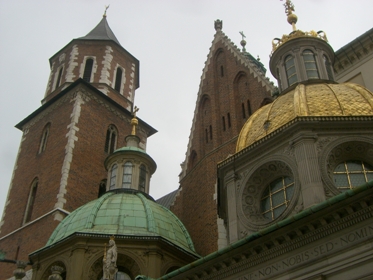
 27/01 Memory day: weekend in Krakow with a visit to the camp of Birkenau
27/01 Memory day: weekend in Krakow with a visit to the camp of Birkenau

filled by Giulia & Romeo

Krakow is a beautiful town that will welcome you in a friendly atmosphere and rich history ... you will walk accompanied by notes of sadness for the Memory and the weight of a troubled past that the city has not forgotten and continues to honor with memory, to which it now opposes a simple and healthy vitality that can you discover in many streets and corners of the city.
In a weekend you will be able to admire the Old Town (Stare Miasto), the Wawel Hill with Royal Castle and Cathedral, the Jewish quarter with its 7 synagogues and the cemetery.
You can also get out of town to see the Salt Mine and the concentration camp of Birkenau ( there are agencies that organize day tours combining visits to both).
The churches and monasteries of the old town of Krakow are so numerous that not only gave them the reputation of a small Roma but already in 1978 the city was declared a World Heritage Site. There are Romanesque churches (Sant 'Andrea, Sant' Adalbert), Gothic churches (Assumption of the Blessed Virgin Mary, St. Francis of Assisi, Holy Cross, Santa Barbara, San Marco) and baroque churches (St. Peter's and Paul and St. Anne).
The Wawel Hill is one of the prettiest spots in town. It 's called' "Polish Acropolis", here are the most important monuments, the Royal Castle and Cathedral, the tomb of St. Stanislaus, the patron saint of Poland, where they rest forever all the Polish kings.
Among other things to see in the city there is Market Square in Old Town, one of the largest medieval squares in all of Europe, around which overlook beautiful buildings and the Basilica of the Assumption of the Blessed Virgin Mary , where at every point hour you can now attend to the sound of the trumpet from the main tower of the church. Don’t loose the Collegium Shift too, one of the world's oldest university buildings, where they studied, among the others, Nicolaus Copernicus and Pope John Paul II. We all know that Wojtyla Pope was born here.
The district Kazimierz, divided into a Jewish and Christian parts, now has only 300 Jews. After the Nazi deportations, the Jewish community, which counted 65,000 Jews, down to 6000. Today only 300 remain, and their culture is witnessed by the numerous synagogues restored. These are the places where Steven Spielberg filmed the famous movie, Schindler's List, which tells the true story of an industrialist who saved many Jews, more tha ine thousand.
This area is now very welcoming and full of life, full of Cafè and restaurants.
We suggest to discover this district with a jewish guide, that reveal you a lot of things that you don’t read on books.
THE SALT MINE in Wieliczka, called the underground salt cathedral of Poland is located in the metropolitan area of Krakow and is one of the oldest salt mines still operating in the world. During the Second World War was used by German occupation troops for war production facilities. It has 3.5 km available for sightseeing (less than 1% of the total length of tunnels), that include statues of historical figures and mythical, the miners carved directly into the salt. Even the crystal chandeliers have been forged in the halls. The mine also has decorated rooms, underground lakes and chapels.
BIRKENAU
It was the immense camp which killed over a million and one hundred thousand people, the overwhelming majority of Jews, Russians, Poles and Gypsies. He came to count up to more than 100,000 prisoners simultaneously present. It was equipped with four large Crematoria and "Pyres ', burning pits continuously day and night.
The inmates, divided in different sectors separately male and female, were used for forced labor or living there temporarily awaiting transfer to other camps. Located in the heart of Europe, the extermination camp of Auschwitz Birkenau became operational in 1941. Through the railways the Nazis deported, in 1942, Jews from Western Europe and South America, from 1944 they were taken off trains directly to the camp. The death structures were destroyed by the fleeing Nazis at the arrival of the Allies. They were construction plans, rubble but, above all, evidence of the few survivors.
(Photograph of Fabio Iotti)
If besides visit Krakow you desire also to improve your English language or any other foreign language travelling all around the world...
click here:

www.letworld.it
|
|






















